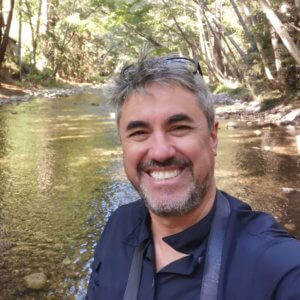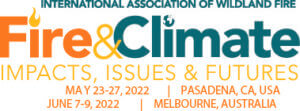IAWF NEWS
IAWF MEETS WITH TOP U.S. OFFICIALS
On Sept. 9, president Toddi Steelman, executive director Mikel Robinson, and past president Tom Zimmerman participated in a video conference with Meryl Harrell, deputy under-secretary for Natural Resources and Environment for the US Department of Agriculture, on behalf of the association and our members. Also in attendance were Chris French, US Forest Service deputy chief, National Forest System, and Mary Snieckus, US Forest Service. Meetings such as this are conducted whenever possible to discuss important wildland fire management issues with national leaders, encourage attention, and discuss mutual support.
During this call, IAWF personnel provided background information on our organization, our activities and products, how we support wildland fire management, and how we support wildland fire organizations. Wildland fire management topics of concern mentioned included diversity and inclusivity, conference attendance and continuing education, firefighter pay equity and staffing, climate change, prescribed fire and fuel treatment, and fire research budgets.
Much of the discussion focused on IAWF’s belief in the importance of and continued support to the National Cohesive Wildland Fire Management Strategy and implementation. Harrell has graciously agreed to be a keynote speaker for the 4th National Cohesive Strategy Workshop Oct. 4-8, and some discussion involved her presentation and areas of interest to participants.
As the available time was short, written materials on all these topics were provided to the under-secretary and her staff for further review, and the IAWF participants enthusiastically agreed to any follow-up conversations as needed.
AWARDS NOMINATIONS OPEN
The nomination period for IAWF’s 2022 awards opens Sept. 23 and runs through Dec. 2.
IAWF strongly encourages members to consider friends and colleagues who have excelled in research, mentoring, service, safety, and management as potential award recipients. If you have nominated someone in the past who did not receive an award, consider nominating that person again!
There are four awards: the Ember Award for Excellence in Fire Safety; the Firebreak Award for Excellence in Fire Management; the Early Career Award in Fire Science; and the Early Career Award in Fire Operations.
Visit. https://www.iawfonline.org/awards/ for details and nomination forms.
NEW IAWF PRESIDENT BEGINS TERM JAN. 1
 IAWF board member Joaquin Ramirez has been elected incoming president; he begins his term Jan 1. Ramirez is a wildland fire technologist who has been working for 25 years to bridge the gap between scientists and end-users. In 2013, Ramirez moved from Spain to San Diego, where he works with agencies worldwide trying to convert science into actionable tools. Ramirez is the creator of several of the most advanced fire behavior software model implementations and decision support systems, including the Wildfire Analyst and fiResponse software tools. From 2011, Ramirez coordinated the first European M.S. in Forest Fires (www.masterfuegoforestal.es) with colleagues at Prof. Rodriguez y Silva (University of Cordoba, Spain) and Prof. Molina (University of Lleida)). Ramirez is also a founder and active member of the Pau Costa Foundation. He earned his PhD in remote sensing and GIS at the University of Leon in 2003, an MS in forestry from the University of Lleida, and his BS in forest engineering from the Polytechnical University of Madrid, Spain.
IAWF board member Joaquin Ramirez has been elected incoming president; he begins his term Jan 1. Ramirez is a wildland fire technologist who has been working for 25 years to bridge the gap between scientists and end-users. In 2013, Ramirez moved from Spain to San Diego, where he works with agencies worldwide trying to convert science into actionable tools. Ramirez is the creator of several of the most advanced fire behavior software model implementations and decision support systems, including the Wildfire Analyst and fiResponse software tools. From 2011, Ramirez coordinated the first European M.S. in Forest Fires (www.masterfuegoforestal.es) with colleagues at Prof. Rodriguez y Silva (University of Cordoba, Spain) and Prof. Molina (University of Lleida)). Ramirez is also a founder and active member of the Pau Costa Foundation. He earned his PhD in remote sensing and GIS at the University of Leon in 2003, an MS in forestry from the University of Lleida, and his BS in forest engineering from the Polytechnical University of Madrid, Spain.
IAWF board members celebrated Ramirez’s election as president during their monthly meeting in August. Ramirez was both humbled and delighted by the faith his peers have in him to carry out the duties of president.
TWO CONTINENTS, TWO CONFERENCES

Start planning now for the IAWF Fire & Climate conference in 2022. There are two segments: May 23-27 in Pasadena; and June 7-9 in Melbourne. Our conference page is up and running at https://fireandclimateconference.com, and the call for speakers is open. Information for exhibitors sponsors, volunteers will be available shortly.
Fire and Climate 2022 will bring attention to one of the most important forces shaping wildfire, and better prepare how we can focus and respond to this formidable challenge in the new decade.
The Camp Fire in 2018 and the Australian wildfires of 2019-20 highlight the challenges we face as a global wildland fire community. These events are not isolated, nor are they confined to traditionally fire-prone countries. Greece, Bolivia, Chile, Israel, Greenland, Russia, Canada, Spain, and Portugal are among other countries facing similar challenges.
This conference will feature insights, case studies, innovations and opinions from around the world to begin to form a collective, global approach to the wildfire challenge. California has been at the forefront of innovation in wildland fire management and holding a conference in California to fully leverage the lessons learned and adaptive behaviors that will continue to emerge after the Camp Fire will benefit the entire international wildland fire community.
The cascading impacts from fires, the cumulative effects from successive wildfires, and the ability to be resilient in the face of these challenges are a call to the wildland fire community to think smarter and faster, and entertain novel ideas to prepare for, respond to, and recover from these events.
Wildfire is a wicked problem and demands that we address the complexities that contribute to the social, biophysical and design elements that contribute to present-day dilemmas. An international gathering that encompasses the entirety of the wildland fire community will help us address these complexities.
This conference will merge the topics that the IAWF has established over three decades through its regular suite of conferences including the Wildland Fire Safety Summit, Human Dimensions of Wildfire, and the Fire Behavior and Fuels conference. These include the interdependent effects related to human-built infrastructure, land use and housing patterns, insurance availability and viability, air quality and smoke management, community safety, public warnings, combined effects of climate change and fire on values such as biodiversity, carbon storage, water yields and quality, supply of timber, infestations and drought, impact on private businesses and property tax base rising cost of emergency response for federal agencies and states / provinces, as well as the looming financial threat to counties and municipalities, long-term land-management approaches, wildfire response, changing fire behavior and suppression, an firefighter workforce safety, care and well-being.
Harvesting experiences, sharing lessons learned, and anticipating how to address the unforeseen challenges that await, create a pressing need for us to convene an all-hands international conference.
